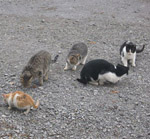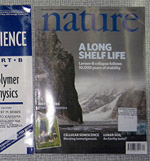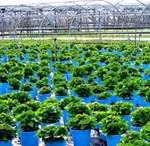When abandoned farmland passively restores back to tidal wetlands
 Agriculture,
Agriculture,  Restoration,
Restoration,  Wetland
Wetland  Overlooking reclaimed agricultural land on the Bay of Fundy.A new study looks at wetland recovery on formerly reclaimed agricultural lands when farming practices are abandoned and the levees are breached.
Overlooking reclaimed agricultural land on the Bay of Fundy.A new study looks at wetland recovery on formerly reclaimed agricultural lands when farming practices are abandoned and the levees are breached.
Graham MacDonald and fellow researchers from McGill and St. Mary's Universities examined how channel networks and pools form in recovering salt marshes previously drained and diked for over a century in the Bay of Fundy, Canada. The team set out to test three hypotheses:
- Recovering tidal salt marshes will have higher channel densities by becoming “hybrid networks” that incorporate previous agricultural ditches.
- Recovering marshes will have less sinuous channels due to incorporation of the rectilinear system of ditches.
- The new hybrid networks will have greater areas of pools from the ponding of some agricultural ditches not incorporated into channels.
The researchers completed field surveys, and analyzed pre-abandonment and present day aerial photographs of two recovering marshes, as well as comparative reference sites for each.
They found that newly forming wetlands have developed extensive channel networks that incorporate agricultural drainage features from the reclamation period but these "hybrid networks" do not have a higher density than reference marshes. The recovery sites did have more dendritic “rivulets,” but not denser networks as a whole.
They did find evidence for their other two hypotheses - that recovering channels are less sinuous and the pools cover a greater area.
Early Acadian populations were the first to drain, ditch, and dike the Bay of Fundy’s salt marshes for flood protection. The early-settling farmers then “reclaimed” the area for agricultural land up into the mid-twentieth century. Farmers built levees and straightened channels to create “ditches,” greatly reducing length, sinuosity, and density of channels as well as inhibiting all tidal flow.
Channels are necessary for herbivore sustenance also known as secondary production. Creek networks and pools facilitate secondary production by sending vegetation down the detrital food web, delivering fish to the marsh surface, and providing feeding and nesting habitats for waterbirds.
Creek dynamics are not typically evaluated to determine restoration success. A previous study by Byers and Chmura in 2007 surveyed plant establishment in salt marshes of the Bay of Fundy. They discovered that the marshes were able to successfully recover vegetation after over 100 years of drainage. This study did not, however, consider the intricate network systems vital to every saline wetland.
MacDonald and fellow researchers suggest that the exclusion of hydrological structures in evaluating restoration success disregards the wetland function of secondary production; channel and pool density should be taken into account along with proximity to vegetated surfaces.
The study findings demonstrate that passive restoration of salt marshes in the Bay of Fundy can reactivate the hydrology needed for primary and secondary production. The authors write,
"Changes in surface hydrology in passively restored wetlands as compared to reference sites can have important ecological consequences. In this study, we have demonstrated that passive restoration can be adequate to provide channel networks of similar density to reference sites, but the sinuosity of individual channel segments may be compromised—possibly lowering the value of this channel as habitat."
--Reviewed by Evyan Borgnis
MacDonald, G., Noel, P., Proosdij, D., & Chmura, G. (2009). The Legacy of Agricultural Reclamation on Channel and Pool Networks of Bay of Fundy Salt Marshes Estuaries and Coasts DOI: 10.1007/s12237-009-9222-4




Reader Comments